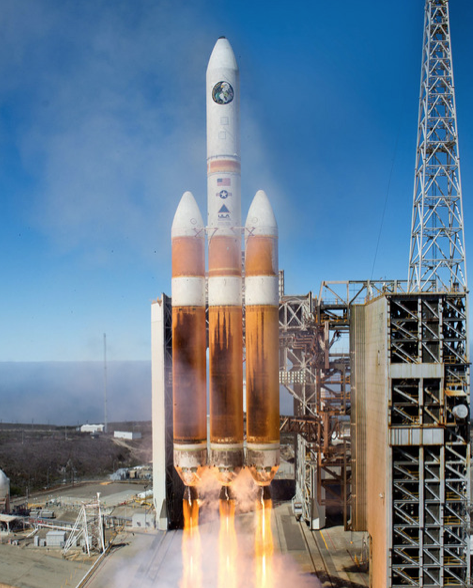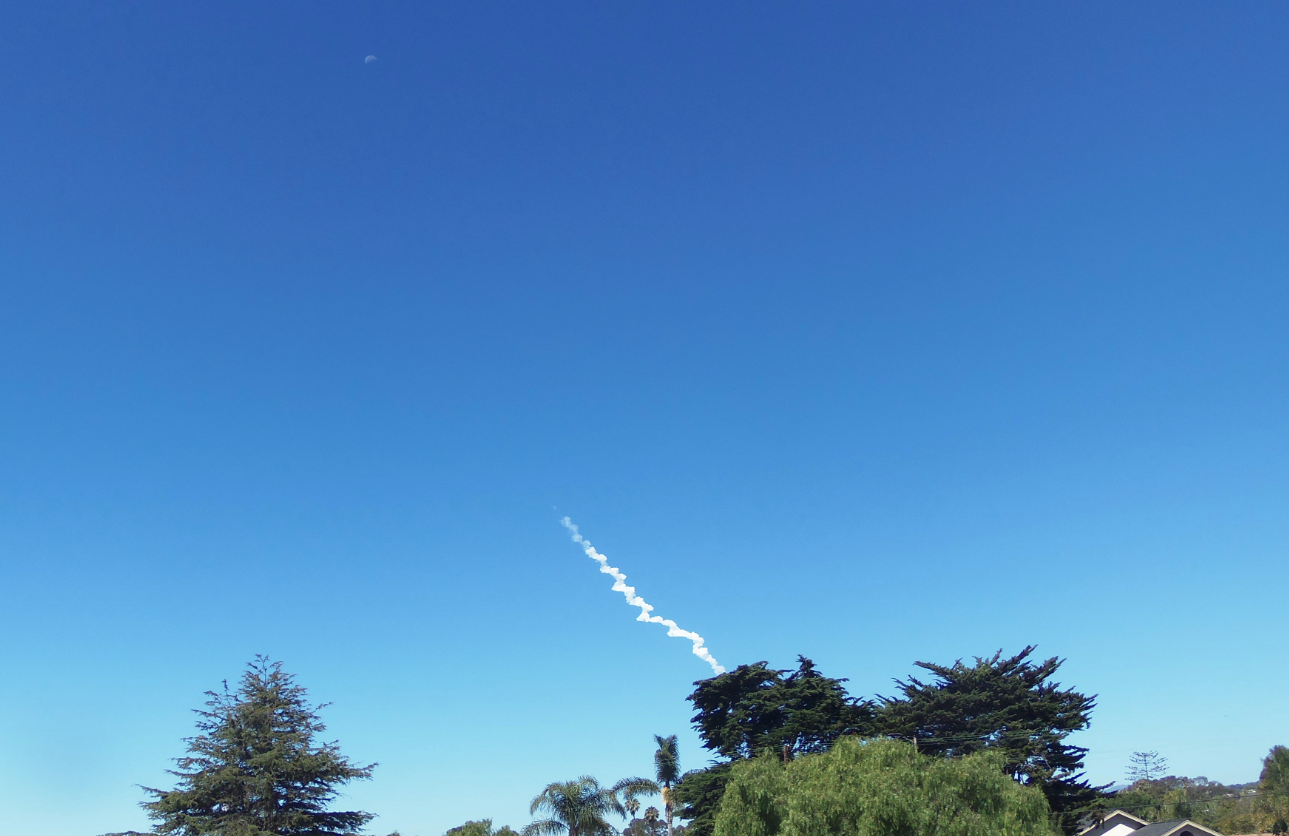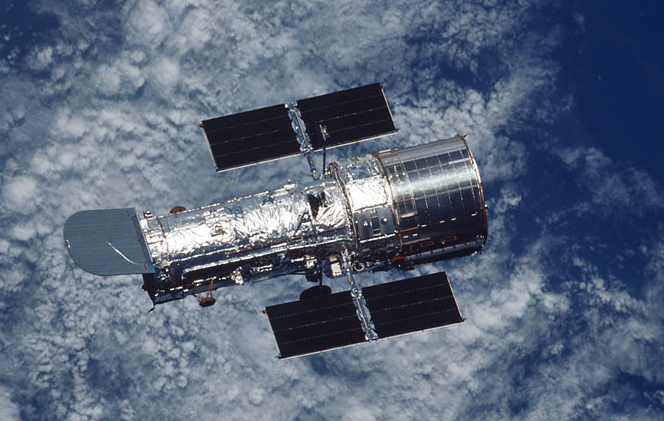Watching You Watching Me
Yesterday morning, at 11:03 PST, a Delta IV Heavy rocket took off from a launch pad at Vandenberg Air Force base. This was only the second launch from VAFB of the most powerful rocket in the U.S.'s quiver. The launch (a video is here) was visible from up to 100 miles away -- in fact, I walked to the roof of my building on campus and watched it. Several minutes after the rocket had soared out of my sight, I heard a low rumble from the launch pad some 60 miles away.
Although details of the satellite are classified, enough information was circulating on aerospace-oriented web sites yesterday to give a rough picture. The missile carried a classified spy satellite mission (codenamed NROL-65) into near-earth orbit. The Delta's payload was a KH-11 (Keyhole) optical imaging satellite, the 16th such satellite to be launched since 1976. Intelligence experts generally assume that yesterday's launch will be the last KH-11 to be boosted into orbit. The design and configuration of the KH-11 (weighing in at about 14 ton and $3+ billion) generally resembles that of the much more familiar Hubble Space Telescope. The key difference, of course, is the direction in which they're pointed.
Although seeing the launch (practically from my office window) was cool, two other things held my attention longer. One was seeing the patches and posters that were made to commemorate yesterday's launch. Check out the subtlety of this:
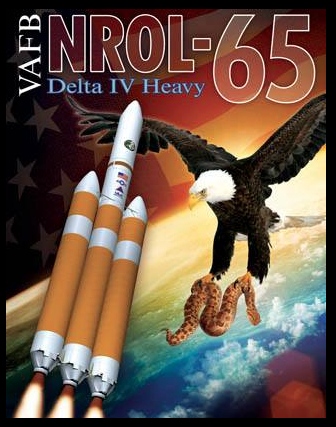 Fans of spy satellites and other classified programs will recognize the ways in which artist-scholar Trevor Paglen has used ephemera like this to speculate on the secret world of military imagery, classified jargon, and various inside jokes. Paglen, in fact, made this sort of divination the basis for a fun and spooky book called I Could Tell You But Then You Would Have to be Destroyed By Me.
Fans of spy satellites and other classified programs will recognize the ways in which artist-scholar Trevor Paglen has used ephemera like this to speculate on the secret world of military imagery, classified jargon, and various inside jokes. Paglen, in fact, made this sort of divination the basis for a fun and spooky book called I Could Tell You But Then You Would Have to be Destroyed By Me.
Consider this image: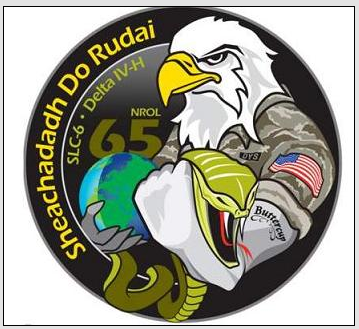 This (mission) patch shows an American eagle holding the planet in its right wing/hand and a snake in its left. The snake's tail is in the form of an omega, perhaps signalling the end of the Keyhole series. Imagery of an eagle with a snake is also found in origin stories and myths in both Mexico and Albania. "Buttercup" is tattooed on the eagle's arm and it's wearing a jacket with another patch reading "DYS." One aerospace web site interpreted this, as well as the inscription running around the patch (the Gaelic Sheachadadh Do Rudai) as shorthand for "Deliver Your Stuff."Then there's this launch patch:
This (mission) patch shows an American eagle holding the planet in its right wing/hand and a snake in its left. The snake's tail is in the form of an omega, perhaps signalling the end of the Keyhole series. Imagery of an eagle with a snake is also found in origin stories and myths in both Mexico and Albania. "Buttercup" is tattooed on the eagle's arm and it's wearing a jacket with another patch reading "DYS." One aerospace web site interpreted this, as well as the inscription running around the patch (the Gaelic Sheachadadh Do Rudai) as shorthand for "Deliver Your Stuff."Then there's this launch patch: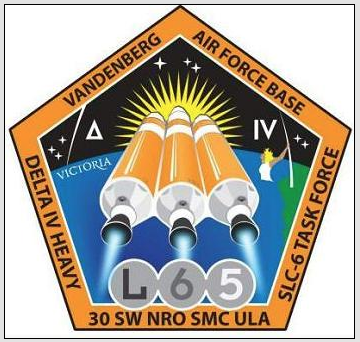 It's just as enigmatic...the Delta IV is flying off into the sunset, right? "Victoria" (the nickname of the rocket...the previous one was called 'Betty') is on the left and a female archer is on the left. We also see the symbol for "delta" and the Roman number 4. It's less clear what the stars on the patch mean. One speculation is that "the groups of three, three and two stars on that patch could represent the three old-generation radar imaging satellites still in service, the three KH-11s which will be in the west plane after this launch, and the two currently in the east plane."Clearly, there's a lot of secrecy involved with such launches as well as the payload. (If you're really interested in secrecy, especially that of the nuclear flavor, you should check out Alex Wellerstein's Restricted Data blog) But, at the same time, it's impossible to hide something as visible as a Delta IV launch. Even the Facebook page for VAFB had details on the launch and subsequent updates.Once the rocket is out of sight, so is its payload, right? Not necessarily... This takes us to the other really interesting part of yesterday's launch. Within a few hours of the Delta IV's ascent - the smoke plume had just drifted out over the Pacific - amateur satellite spotters were already working out the orbital details (see here, for example) of the rocket's KH-11 payload.This information is posted on-line (and frequently updated) on the Visual Satellite Observer's Home Page. An on-line bulletin board and mailing list called SeeSat provides more information.
It's just as enigmatic...the Delta IV is flying off into the sunset, right? "Victoria" (the nickname of the rocket...the previous one was called 'Betty') is on the left and a female archer is on the left. We also see the symbol for "delta" and the Roman number 4. It's less clear what the stars on the patch mean. One speculation is that "the groups of three, three and two stars on that patch could represent the three old-generation radar imaging satellites still in service, the three KH-11s which will be in the west plane after this launch, and the two currently in the east plane."Clearly, there's a lot of secrecy involved with such launches as well as the payload. (If you're really interested in secrecy, especially that of the nuclear flavor, you should check out Alex Wellerstein's Restricted Data blog) But, at the same time, it's impossible to hide something as visible as a Delta IV launch. Even the Facebook page for VAFB had details on the launch and subsequent updates.Once the rocket is out of sight, so is its payload, right? Not necessarily... This takes us to the other really interesting part of yesterday's launch. Within a few hours of the Delta IV's ascent - the smoke plume had just drifted out over the Pacific - amateur satellite spotters were already working out the orbital details (see here, for example) of the rocket's KH-11 payload.This information is posted on-line (and frequently updated) on the Visual Satellite Observer's Home Page. An on-line bulletin board and mailing list called SeeSat provides more information.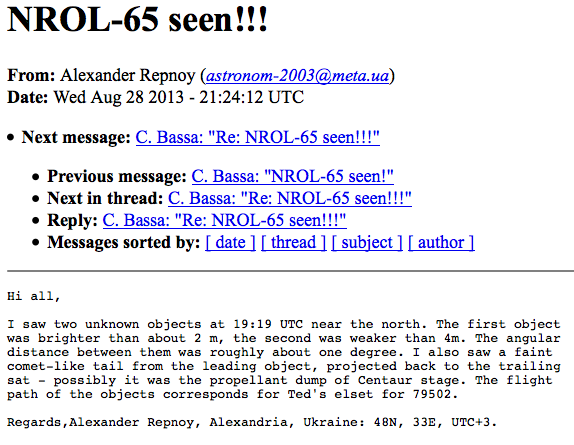 One of the world's most active satellite spotters, Ted Molczan, explained the good luck amateur spotters had with NROL-65. In an email he wrote to me today, he said: "We were fortunate to have experienced observers well-placed to observe the payload in close proximity to its rocket stage (~40 km apart) as they passed over Europe, 78 minutes after launch. The rocket may already have performed the de-orbit burn that caused it to re-enter about half an hour later into the Pacific, near the equator around 154 W. One of the European observers reported venting from the rocket body."Some observers saw the satellite and rocket visually while others used still or motion picture cameras. Doppler radio tracking data was reported in off-list messages, Molczan said. All these observations "yielded an excellent set of initial orbital elements. The orbit is 252 X 996 km, inclined 97.9 deg, with a period of 97.25 min." In other words, if you know where to look at the right time, you'll probably be able to see it.Satellite spotting today is an echo of the Cold War space race. Operation Moonwatch was a program for amateur/citizen scientists that Fred L. Whipple, the director of the Smithsonian Astrophysical Observatory, first organized in 1956 as part of the International Geophysical Year. Whipple’s initial goal was to enlist the aid of amateur astronomers and other citizens who would help “real” scientists spot satellites.
One of the world's most active satellite spotters, Ted Molczan, explained the good luck amateur spotters had with NROL-65. In an email he wrote to me today, he said: "We were fortunate to have experienced observers well-placed to observe the payload in close proximity to its rocket stage (~40 km apart) as they passed over Europe, 78 minutes after launch. The rocket may already have performed the de-orbit burn that caused it to re-enter about half an hour later into the Pacific, near the equator around 154 W. One of the European observers reported venting from the rocket body."Some observers saw the satellite and rocket visually while others used still or motion picture cameras. Doppler radio tracking data was reported in off-list messages, Molczan said. All these observations "yielded an excellent set of initial orbital elements. The orbit is 252 X 996 km, inclined 97.9 deg, with a period of 97.25 min." In other words, if you know where to look at the right time, you'll probably be able to see it.Satellite spotting today is an echo of the Cold War space race. Operation Moonwatch was a program for amateur/citizen scientists that Fred L. Whipple, the director of the Smithsonian Astrophysical Observatory, first organized in 1956 as part of the International Geophysical Year. Whipple’s initial goal was to enlist the aid of amateur astronomers and other citizens who would help “real” scientists spot satellites.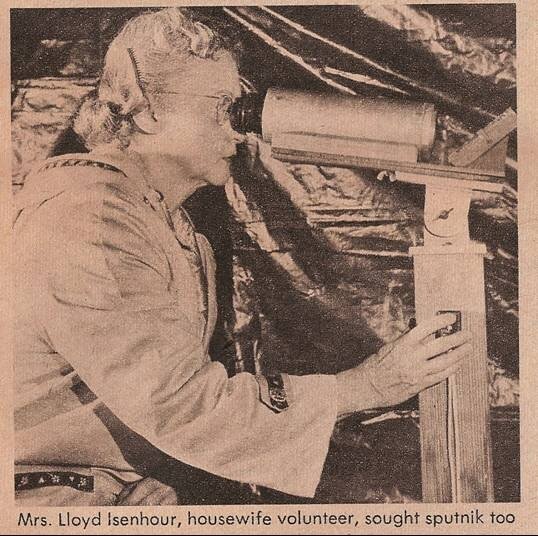
Whipple first imagined Moonwatch as a way for citizens to participate in science and as a supplement to professionally-manned optical and radio tracking stations. But when Sputnik I and II appeared suddenly in late 1957, Moonwatchers around the world found themselves an essential component of the professional scientists’ global tracking network. (My 2008 book Keep Watching the Skies tells the story of Moonwatch).
Satellite spotting today - the kind that Molczan and his associates do - has a very different valence.The political context in which amateur satellite spotters practice their arcane craft has changed since Moonwatch first started. In 1957, amidst the throes of the Cold War, Western scientists, politicians, and military leaders desperately needed information about the new Soviet Sputniks. In response, the American government encouraged amateurs to be vigilant and recognized their contributions in turn. More than 50 years later, with the Cold War over and the U.S. fighting the more nebulous threat of terrorism, some government officials sent a different message: Instead of contributing to national security, some have suggested that amateurs who track top-secret reconnaissance satellites might actually be thwarting it.Ted Molczan was one of the initiates who took up satellite spotting in Moonwatch’s final years. Molczan became especially interested in monitoring clandestine spy satellites. (An on-line interview with him is here.) While the government carefully guards the technical details of spy satellites, the fact remains that they are large orbiting objects that reflect sunlight quite well. In other words, they present a tempting target for amateurs who know where to look. And given that the small yet skilled amateur community can correlate their observations with information aviation magazines and industry newspapers published about launch times, it's relatively simple to identify the actual objects they spotted. As one spokesperson for the National Reconnaissance Office noted in Wired, “If we had our druthers, we would prefer that these things not end up on the Internet.”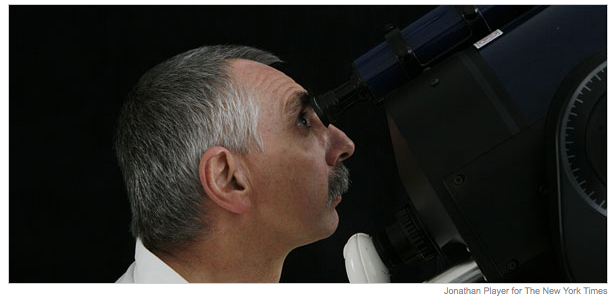 However small their numbers, the amateurs following spy satellites caused consternation for some in the intelligence community. In November 2000, a blue-ribbon congressional commission released a lengthy report on the status of U.S. spy satellite capabilities and the activities of the National Reconnaissance Office. When the commission unveiled its report at the National Press Club, co-chair Sen. Robert Kerrey charged that amateurs who track spy satellites and post their data on the Web aided terrorists and foreign governments wishing to hide illegal activities. ((Vernon Loeb. “Panel Report Reveals Satellite Details.” The Washington Post, November 24, 2000: A41.))There are at least three kinds of irony here. The first and obvious one is that a small international group of amateur spotters - using equipment one could buy at the local Kmart - can locate and track multi-billion dollar classified satellites in the first place.The second is that, at one time, the US government sought out the participation of amateurs for programs like Moonwatch. Keeping tabs on the Soviets was part of the program. Now such activities are seen with quite the gimlet eye.Finally, this summer has been dominated by news and debate about Edward Snowden and the leaking of information about the National Security Agency's covert and (likely) illegal surveillance of American and foreign citizens. I see it as a modest victory of sorts for openness that amateur satellite spotters are looking back.Long after Moonwatch ended, amateurs and professionals hailed it as a model for future amateur-professional collaboration and reflected that the long-lived program helped change the perception of what amateurs could contribute to professional science. Today, when it comes to keeping an eye (as limited as it may be) on the national surveillance state, amateurs have yet another role to perform.
However small their numbers, the amateurs following spy satellites caused consternation for some in the intelligence community. In November 2000, a blue-ribbon congressional commission released a lengthy report on the status of U.S. spy satellite capabilities and the activities of the National Reconnaissance Office. When the commission unveiled its report at the National Press Club, co-chair Sen. Robert Kerrey charged that amateurs who track spy satellites and post their data on the Web aided terrorists and foreign governments wishing to hide illegal activities. ((Vernon Loeb. “Panel Report Reveals Satellite Details.” The Washington Post, November 24, 2000: A41.))There are at least three kinds of irony here. The first and obvious one is that a small international group of amateur spotters - using equipment one could buy at the local Kmart - can locate and track multi-billion dollar classified satellites in the first place.The second is that, at one time, the US government sought out the participation of amateurs for programs like Moonwatch. Keeping tabs on the Soviets was part of the program. Now such activities are seen with quite the gimlet eye.Finally, this summer has been dominated by news and debate about Edward Snowden and the leaking of information about the National Security Agency's covert and (likely) illegal surveillance of American and foreign citizens. I see it as a modest victory of sorts for openness that amateur satellite spotters are looking back.Long after Moonwatch ended, amateurs and professionals hailed it as a model for future amateur-professional collaboration and reflected that the long-lived program helped change the perception of what amateurs could contribute to professional science. Today, when it comes to keeping an eye (as limited as it may be) on the national surveillance state, amateurs have yet another role to perform.
